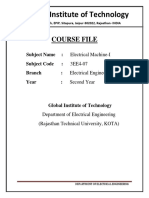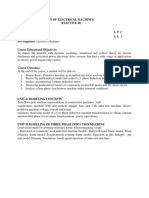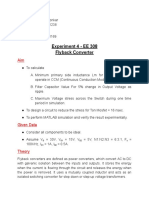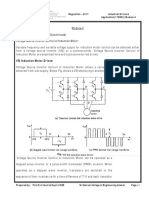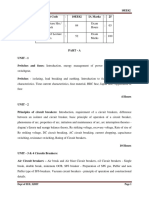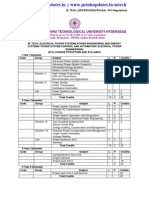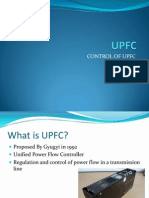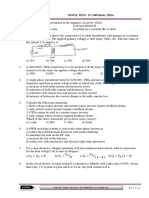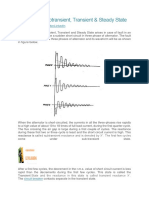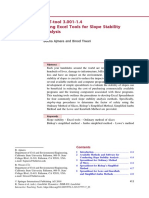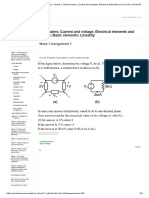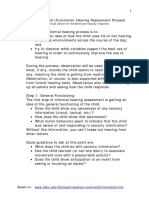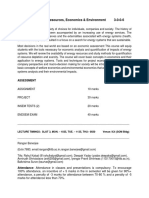HVDCTS Notes
Uploaded by
sparshg0803HVDCTS Notes
Uploaded by
sparshg0803EEE 474: HVDC TRANSMISSION SYSTEMS
LT P
310
Module 1: DC Transmission Technology (4 hours)
Comparison of AC and dc Transmission (Economics, Technical Performance and Reliability).
Application of DC Transmission. Types of HVdc Systems. Components of a HVdc system. Line
Commutated Converter and Voltage Source Converter based systems.
Module 2: Analysis of Line Commutated and Voltage Source Converters (10 hours)
Line Commutated Converters (LCCs): Six pulse converter, Analysis neglecting commutation overlap,
harmonics, Twelve Pulse Converters. Inverter Operation. Effect of Commutation Overlap.
Expressions for average dc voltage, AC current and reactive power absorbed by the converters.
Effect of Commutation Failure, Misfire and Current Extinction in LCC links.
Voltage Source Converters (VSCs): Two and Three-level VSCs. PWM schemes: Selective Harmonic
Elimination, Sinusoidal Pulse Width Modulation. Analysis of a six pulse converter. Equations in the
rotating frame. Real and Reactive power control using a VSC.
Module 3: Control of HVDC Converters: (10 hours)
Principles of Link Control in a LCC HVDC system. Control Hierarchy, Firing Angle Controls –
Phase-Locked Loop, Current and Extinction Angle Control, Starting and Stopping of a Link. Higher
level Controllers Power control, Frequency Control, Stability Controllers. Reactive Power Control.
Principles of Link Control in a VSC HVDC system: Power flow and dc Voltage Control. Reactive
Power Control/AC voltage regulation.
Module 4: Components of HVDC systems: (8 hours)
Smoothing Reactors, Reactive Power Sources and Filters in LCC HVDC systems DC line: Corona
Effects. Insulators, Transient Over-voltages. dc line faults in LCC systems. dc line faults in VSC
systems. dc breakers. Monopolar Operation. Ground Electrodes.
Module 5: Stability Enhancement using HVDC Control (4 hours)
Basic Concepts: Power System Angular, Voltage and Frequency Stability. Power Modulation: basic
principles – synchronous and asynchronous links. Voltage Stability Problem in AC/dc systems.
Module 6: MTdc Links (4 hours)
Multi-Terminal and Multi-Infeed Systems. Series and Parallel MTDC systems using LCCs. MTDC
systems using VSCs. Modern Trends in HVDC Technology. Introduction to Modular Multi-level
Converters.
Text/References:
1. K. R. Padiyar, “HVDC Power Transmission Systems”, New Age International Publishers, 2011.
2. J. Arrillaga, “High Voltage Direct Current Transmission”, Peter Peregrinus Ltd., 1983.
3. E. W. Kimbark, “Direct Current Transmission”, Vol.1, Wiley-Interscience, 1971.
Course Outcomes:
1. Undestand the advantage of DC transmission over AC transmission.
2. Understand the importance of line commutated converters
3. Understand the importance of voltage source converters
4. Undersatnd the control strategies in HVDC system
5. Explain the improvements in power system stability using HVDC.
Module 1: DC Transmission Technology
Comparison of AC and dc Transmission (Economics, Technical Performance and Reliability):
Application of DC Transmission:
Types of HVdc Systems:
Components of a HVdc system:
Line Commutated Converter:
Voltage Source Converter based systems:
Module 2: Analysis of Line Commutated and Voltage Source Converters
Line Commutated Converters (LCCs):
Six pulse converter:
Analysis neglecting commutation overlap:
Harmonics:
Twelve Pulse Converters:
Inverter Operation:
Effect of Commutation Overlap:
Expressions for average dc voltage:
AC current and reactive power absorbed by the converters:
Effect of Commutation Failure:
Misfire and Current Extinction in LCC links:
Voltage Source Converters (VSCs): Two and Three-level VSCs:
PWM schemes:
Selective Harmonic Elimination:
Sinusoidal Pulse Width Modulation:
Analysis of a six pulse converter:
Equations in the rotating frame:
Real and Reactive power control using a VSC:
Module 3: Control of HVDC Converters:
Principles of Link Control in a LCC HVDC system:
Control Hierarchy:
Firing Angle Controls – Phase-Locked Loop:
\
Current and Extinction Angle Control:
Starting and Stopping of a Link:
Higher level Controllers Power control and Frequency Control:
Stability Controllers:
Reactive Power Control:
Principles of Link Control in a VSC HVDC system:
Power flow and dc Voltage Control:
Reactive Power Control/AC voltage regulation.
Module 4: Components of HVDC systems: (8 hours)
Smoothing Reactors:
Reactive Power Sources and Filters in LCC HVDC systems:
DC line:
Corona Effects:
Insulators:
Transient Over-voltages:
DC line faults in LCC systems and DC line faults in VSC systems:
DC breakers:
Monopolar Operation:
Ground Electrodes:
Module 5: Stability Enhancement using HVDC Control
Basic Concepts:
Power System Angular:
Voltage and Frequency Stability:
Power Modulation:
Basic principles – synchronous and asynchronous links:
Voltage Stability Problem in AC/dc systems:
Module 6: MTdc Links
Multi-Terminal and Multi-Infeed Systems:
Series and Parallel MTDC systems using LCCs and MTDC systems using VSCs:
Modern Trends in HVDC Technology:
Introduction to Modular Multi-level Converters:
You might also like
- Bidirectional Battery Charger Circuit Using BuckBoost Converter100% (1)Bidirectional Battery Charger Circuit Using BuckBoost Converter6 pages
- Simulation of Some Power System, Control System and Power Electronics Case Studies Using Matlab and PowerWorld SimulatorFrom EverandSimulation of Some Power System, Control System and Power Electronics Case Studies Using Matlab and PowerWorld SimulatorNo ratings yet
- Subject Name: Electric Drive Subject Code: 6EE4-05: Introduction: Objective, Scope and Outcome of The CourseNo ratings yetSubject Name: Electric Drive Subject Code: 6EE4-05: Introduction: Objective, Scope and Outcome of The Course9 pages
- PS7005 High Voltage Direct Current TransmissionNo ratings yetPS7005 High Voltage Direct Current Transmission11 pages
- EE3401 QB 01 2MARKS - by LearnEngineering - inNo ratings yetEE3401 QB 01 2MARKS - by LearnEngineering - in9 pages
- Rao Bahadur Y Mahabaleswarappa Engineering College, Ballari: Digital Phase Selector0% (1)Rao Bahadur Y Mahabaleswarappa Engineering College, Ballari: Digital Phase Selector14 pages
- Experiment 4 - EE 308 Flyback ConverterNo ratings yetExperiment 4 - EE 308 Flyback Converter19 pages
- SB8028-Design of Photo Voltaic System Lab (NM)No ratings yetSB8028-Design of Photo Voltaic System Lab (NM)27 pages
- Nptel: High Voltage DC Transmission - Web Course0% (1)Nptel: High Voltage DC Transmission - Web Course2 pages
- Excitation Phenomena in Transformers Excitation Phenomena With Out Hysteresis100% (1)Excitation Phenomena in Transformers Excitation Phenomena With Out Hysteresis2 pages
- Comparison Between VSI and CSI Fed Induction Motor Drives in MATLAB Environment Based On THD Performance100% (2)Comparison Between VSI and CSI Fed Induction Motor Drives in MATLAB Environment Based On THD Performance71 pages
- Applications of Power Electronics To Power SystemsNo ratings yetApplications of Power Electronics To Power Systems8 pages
- Speed Control of A Separatelyexcited DC PDFNo ratings yetSpeed Control of A Separatelyexcited DC PDF14 pages
- A Single-Phase Cascaded H-Bridge Multilevel Inverter With Reduced Switching Devices and HarmonicsNo ratings yetA Single-Phase Cascaded H-Bridge Multilevel Inverter With Reduced Switching Devices and Harmonics4 pages
- Eee-Vi-Switchgear & Protection (10ee62) - Notes PDFNo ratings yetEee-Vi-Switchgear & Protection (10ee62) - Notes PDF92 pages
- Simulation Objective:: Electrical Engineering, VIII-Semester Ee 804 Simulation Lab Experiment 8No ratings yetSimulation Objective:: Electrical Engineering, VIII-Semester Ee 804 Simulation Lab Experiment 86 pages
- Eet418 Electric and Hybrid Vehicles, June 2023No ratings yetEet418 Electric and Hybrid Vehicles, June 20232 pages
- Methods of Improving Transient StabilityNo ratings yetMethods of Improving Transient Stability2 pages
- Power System Protection Lab: Department of Electrical EngineeringNo ratings yetPower System Protection Lab: Department of Electrical Engineering33 pages
- Modeling of The Solid Rotor Induction MotorNo ratings yetModeling of The Solid Rotor Induction Motor5 pages
- sheets_Sheet (10) Power System Engineering (1)No ratings yetsheets_Sheet (10) Power System Engineering (1)2 pages
- Half-Bridge and Full-Bridge Converters Half-Bridge ConverterNo ratings yetHalf-Bridge and Full-Bridge Converters Half-Bridge Converter2 pages
- Solar Power Train With Automatic Crossing Gates: Project Report On100% (1)Solar Power Train With Automatic Crossing Gates: Project Report On56 pages
- Concept of Subtransient, Transient & Steady State: FacebookwhatsapptwitterlinkedinNo ratings yetConcept of Subtransient, Transient & Steady State: Facebookwhatsapptwitterlinkedin4 pages
- A Case Study for a Single-Phase Inverter Photovoltaic System of a Three-Bedroom Apartment Located in Alexandria, Egypt: building industry, #0From EverandA Case Study for a Single-Phase Inverter Photovoltaic System of a Three-Bedroom Apartment Located in Alexandria, Egypt: building industry, #0No ratings yet
- An Informal Functional Hearing Assessment ProcessNo ratings yetAn Informal Functional Hearing Assessment Process4 pages
- Maxham - Modeling Customer Perceptions of Complaint Handling Over Time The Effects of Perceived Justice On Satisfaction and Intent VVNo ratings yetMaxham - Modeling Customer Perceptions of Complaint Handling Over Time The Effects of Perceived Justice On Satisfaction and Intent VV14 pages
- EN 606/ 403 Energy Resources, Economics & Environment 3-0-0-6No ratings yetEN 606/ 403 Energy Resources, Economics & Environment 3-0-0-64 pages
- Standard for Study and Design Approval of Water workNo ratings yetStandard for Study and Design Approval of Water work10 pages
- BUS 511-Midterm-Test - 1-SampleQuestionsNo ratings yetBUS 511-Midterm-Test - 1-SampleQuestions3 pages
- Batas Pambansa Blg. 878: Published in The Official Gazette, Vol. 81 No. 35 Page 3821 On September 2, 1985No ratings yetBatas Pambansa Blg. 878: Published in The Official Gazette, Vol. 81 No. 35 Page 3821 On September 2, 19851 page
- 5.6.1 Transmission Modes: 5.6.2.1 Segmentation of LLC Pdus Into RLC Data BlocksNo ratings yet5.6.1 Transmission Modes: 5.6.2.1 Segmentation of LLC Pdus Into RLC Data Blocks8 pages
- ( M M M) Cost and Return Analysis of The Effective Microorganism Technology in Barangay Olongtao IlayaNo ratings yet( M M M) Cost and Return Analysis of The Effective Microorganism Technology in Barangay Olongtao Ilaya20 pages
- مدى تلائم القياسات الأنثروبومترية للأثاث الجامعي مع الأبعاد الجسمية للطلبة مجلة100% (1)مدى تلائم القياسات الأنثروبومترية للأثاث الجامعي مع الأبعاد الجسمية للطلبة مجلة10 pages
- Brick Bats Cement Concrete Cost Estimate Excel SheetNo ratings yetBrick Bats Cement Concrete Cost Estimate Excel Sheet5 pages






